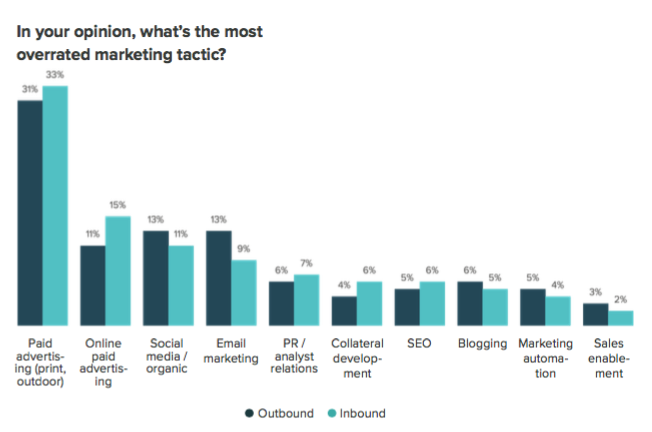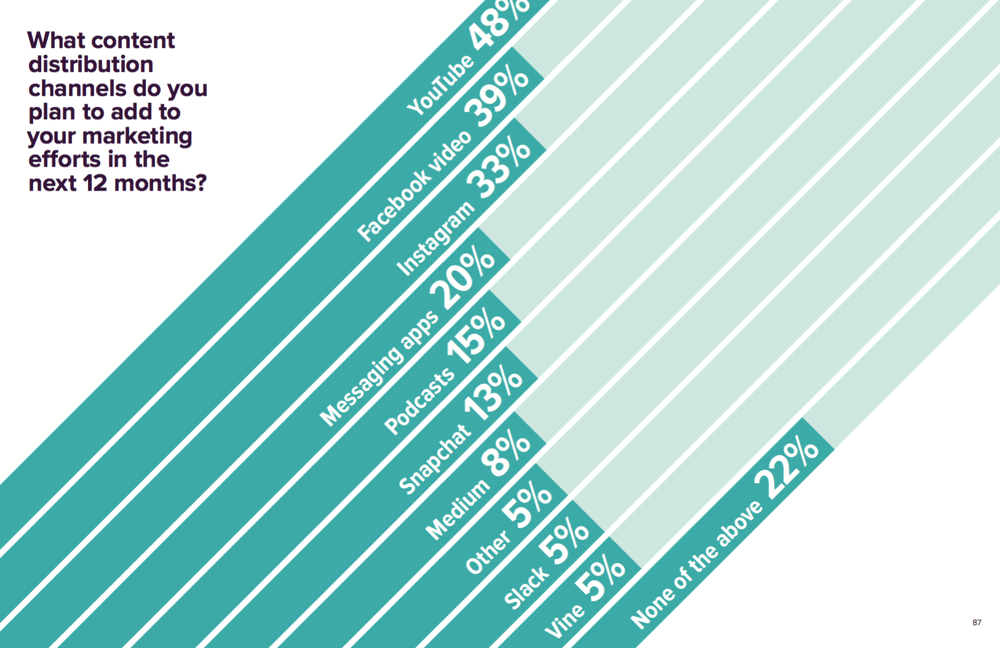It's no shock to our crew at Illumine8 that respondents to HubSpot's State of Inbound survey indicated that most outbound paid advertising--print ads, direct mail, signage, among other tactics--was overrated.
After all, paid advertising and print-anchored tactics are the main engine of an outbound marketing approach.
What's more interesting, in our humble opinion, is what some of the 4,500 respondents from across 132 countries had to say about where they might spend their marketing dollars in the future.
So, if outbound marketing is not worth the budget dollars, what is?
What are the most overrated marketing tactics?

- Paid advertising disappoints.
Traditional paid, print advertising, or direct mail (the main engines of a purely outbound approach), whether employed by an outbound or Inbound agency, clearly let some businesses down. 31% of outbound marketers and 33% of Inbound firms rated outbound tactics as overrated. - Even digital paid ads fell flat.
Again, regardless of an agency's philosophy, online paid advertising also did not do the job with 11% of outbound focused agencies and 15% of Inbound organizations reporting less than ideal performance. - Add it all up...
42% of outbound agencies reported any paid advertising as overrated, whereas 48% of Inbound firms felt paid tactics were overrated.
What does overrated really mean?
To be fair, the term "overrated" is a highly subjective term that could mean different things to different individuals. However, no matter which metric you look at--leads generated, cost-per-lead, lead quality or conversion rates--over 40% of polled businesses are not getting the desired results with paid outbound tactics.
If we examine the most traditional of paid tactics, the print ad, we can perhaps define "overrated" more succinctly.
This classic outbound tactic will appear in a magazine or newspaper run across a few weeks and at a fairly significant cost depending on the size of the ad, whether it's color or black and white and page placement (i.e. front cover, back cover, highly read pages, etc.).
The call-to-action will likely be a phone number to call, or something even more vague like "visit" us, both of which do not provide sophisticated tracking options.
Let's look at a hypothetical scenario:
- Let's say the print ad run costs $1,800 (this is a ballpark cost for a half page ad in a local newspaper in a small city market).
- The ad generates 10 phone calls. 5 of those leads wind up not being high quality leads, and 2 leads are just not yet ready to buy.
- That leaves 3 qualified leads.
- If you close 33% of these (which is a crazy-high closing rate for a print ad) that will result in a single sale at $1,800 cost-per-sale.
- Now, there are multiple scenarios where an $1,800 cost per sale could be great. However, in many cases and for many business, this is not an ideal number. Note: this $1,800 cost is just placement, not the staff or outsourced labor time to create, write and coordinate the ad.
If you compare the print ad to a blog post with a strong downloadable asset, the term "overrated" becomes even more clearly defined.
- A blog post can take a less experienced staff blogger about 3 hours to complete on average. The downloadable asset might take another 3 hours.
- Six hours of labor at, let's say, your $40 an hour pay rate (again, a ballpark figure for an individual contributor blogger with some industry experience) equals $240 in staff time.
- Let's say this blog gets 65 views over a month and 10 people download the asset, providing your business email contact information to do so.
- 1 person that downloaded the asset becomes a customer eventually.
- That's a cost-per-lead of $24 and a cost-per-sale of $240, which is 7.5 times lower than the print ad.
You can certainly punch holes in the numbers above, but the bottom line is that print ads represent a significantly more expensive hard cost that is significantly less targeted to the buyer's journey than a blog post.
Let's break this down:
- Print ads are almost always more expensive than blog posts and have less shelf life.
- The print ad only has a temporary run where the blog post stays visible forever, adding to your SEO equity along the way and generating additional views if the content is strong.
- Unless you employ tracking numbers on print ads (which is an added cost) or provide an ad code, the intel you gather on a caller will only be as good as the staffer that answers the call.
- The blog post, if you utilize HubSpot or another software program, can capture actionable data even if the viewer does not provide email information to obtain the asset.
- The blog post provides a clear pathway via links and your website to move the viewer along the buyers journey, whereas the print ad either produces a call or is a dead end--there's really no middle ground.
- The blog post provides a potential lead or customer with value immediately and builds trust and thought leadership positioning over time.
- A print ad is transient and likely not repeatable over a long period of time due to cost. Moreover, because it is a temporary tactic and not viable for the long term, by its very nature it needs to sell aggressively rather than provide value.
- And, oh yeah, the blog could cost 7.5 times less and is nearly always more targeted and agile than a print ad.
This is not to say that print advertising or direct mail has no place in a marketing program. It still does, but not as the anchor or primary lead tactic; it is supplemental at best and most effective when used sparingly in the right situations.
At Illumine8, we call our approach Unbound marketing, which uses both traditional and non-traditional means to build an integrated campaign tailored specifically to your needs.
Again, there are many variables that exist when it comes to categorizing an approach as "overrated." But it's easy to see, with its higher cost and inflexibility, why outbound tactics like print ads and direct mail could be viewed as "overrated."
What's the Future of Marketing Look Like?
So, if a high percentage of businesses similar to yours feel traditional, outbound paid methods are overrated and not cost effective, where will they look for better results?
Video. Podcasts. And more video.
State of Inbound respondents say they will look to invest budget dollars in video-based tactics via YouTube, Facebook and Instagram.

48% and 39% of respondents indicated YouTube and Facebook video, respectively, as a likely addition to marketing efforts over the next year. Instagram was in the top three with Podcasts occupying the 5th slot at 20%.
This indicates a clear trend to explore outside of comfort zones into what might be unchartered territory for many businesses.
Examining State of Inbound's data reveals the continuing appeal of Inbound strategies and tactics and the willingness of businesses to invest valuable budget dollars where it makes the most sense--in mediums that offer flexibility, exciting content possibilities, great value to them and to their potential customers, and, most importantly, that their audience consumes willingly on a regular basis.
At Illumine8 we believe traditional, paid marketing still has a place when used sparingly, in a hyper-targeted manner and as part of a wider, integrated Unbound marketing strategy.
But the days of marketing successfully via a program anchored by print are over.
Looking to explore what a fully integrated—or Unbound—marketing approach can do for your business?
